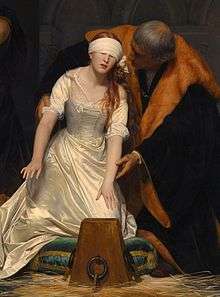John Brydges, 1st Baron Chandos

John Brydges, 1st Baron Chandos (9 March 1492 – 12 April 1557[1]) was an English Member of Parliament and later peer. His last name is also sometimes spelt Brugge or Bruges.[2]
Biography
John Brydges was born at Coberley, Gloucestershire,[1] the son of Sir Giles Brydges[3] of Coberley (c.1462–1511) and Isabel Baynham. He was a prominent figure at the English court during the reigns of Kings Henry VIII and Edward VI and of Queen Mary I.[4] Brydges was High Sheriff of Wiltshire for 1537,[1] and took part in suppressing the rebellion of Sir Thomas Wyatt in 1554.[3] As Lieutenant of the Tower of London during the earlier part of Queen Mary's reign, he had the custody not only of Lady Jane Grey and of Thomas Wyatt, but for a short time, of the Queen's half-sister as well, the Princess Elizabeth Tudor (who would later become Queen Elizabeth I of England).[3] At some point, Brydges was also MP for Gloucestershire.
In 1554, Queen Mary I gave Sudeley Castle to John Brydges and created him Baron Chandos of Sudeley on 8 April 1554.[2] The castle remained his property throughout her reign and the reign of Queen Elizabeth I as well and then passed down to his descendants. It was at Sudeley Castle that Queen Elizabeth was entertained three times. Also, later on in 1592, a spectacular three-day feast was held there to celebrate the anniversary of the defeat of the Spanish Armada.
Family
.jpg)
It was around 1512 when Brydges married Elizabeth Grey, daughter of Edmund Grey, 9th Baron Grey de Wilton (died 1511), and Florence Hastings, eldest daughter of Sir Ralph Hastings.[5] They had eleven children. Their son Edmund succeeded to the Chandos barony on his father's death.[4] Their son Charles married Jane, daughter of Sir Edward Carne.[6] Their daughter Katherine married Edward Sutton, 4th Baron Dudley.[7]
Death
He died at Sudeley Castle 12 April 1557[2] and was buried with heraldic ceremony on 3 May in Sudeley Church.[8] His will, dated 2 March 1556,[1] was proved 28 May 1557.[2][9] In his will, he styles himself as Sir John Bruges, Knight, Lord Chandos of Sudeley.
Notes
- 1 2 3 4 Kirk & Dale 1982.
- 1 2 3 4 Cokayne III 1913, p. 126.
- 1 2 3 Chisholm 1911.
- 1 2 Lee 1886, pp. 163–164.
- ↑ Richardson IV 2011, pp. 350–1.
- ↑ Cokayne II 1902, p. 15.
- ↑ Cokayne IV 1916, pp. 481–482.
- ↑ Machyn 1848, pp. 133, 356.
- ↑ Public Record Office, prob. 11/30
References
- Cokayne, G. E., ed. (1902). Complete Baronetage. II:1625–1649. Exeter: Pollard & Co.
- Cokayne, G. E. (1913). Gibbs, Vicary; Doubleday, H. Arthur, eds. The Complete Peerage of England, Scotland, Ireland, Great Britain and the United Kingdom, Extant, Extinct or Dormant. III. London: St. Catherine Press.
- Cokayne, G. E. (1916). Gibbs, Vicary, ed. The Complete Peerage of England, Scotland, Ireland, Great Britain and the United Kingdom, Extant, Extinct or Dormant. IV. London: St. Catherine Press.
- "John Brydges, (1st B. Chandos of Sudeley)". Tudorplace.com.ar. Retrieved 30 January 2009.
- Kirk, L. M.; Dale, M. K. (1982). "Brydges, Sir John (1492–1557), of Coberley, Glos.". In Bindoff, S. T. Members. The History of Parliament: the House of Commons 1509–1558. The History of Parliament Trust. Retrieved 11 March 2014.

- Machyn, Henry (1848). Nichols, John Gough, ed. The Diary of Henry Machyn, Citizen and Merchant-Taylor of London, from A. D. 1550 to A. D. 1563. [Camden Society. Publications]. XLII. Edited by John Gough Nichols. London: Printed for the Camden Society by J. B. Nichols and Son.
- Richardson, Douglas (2011). Everingham, Kimball G., ed. Magna Carta Ancestry: A Study in Colonial and Medieval Families. IV (2nd ed.). Salt Lake City. ISBN 1460992709. Retrieved 8 October 2013.
Attribution

External links
- Bydges, Sir John (1492–1557), of Coberley, Glos. A biography
- Sir John Brydges, 1st Lord Chandos Family tree
| Peerage of England | ||
|---|---|---|
| New creation | Baron Chandos 2nd creation 1554–1557 |
Succeeded by Edmund Brydges |